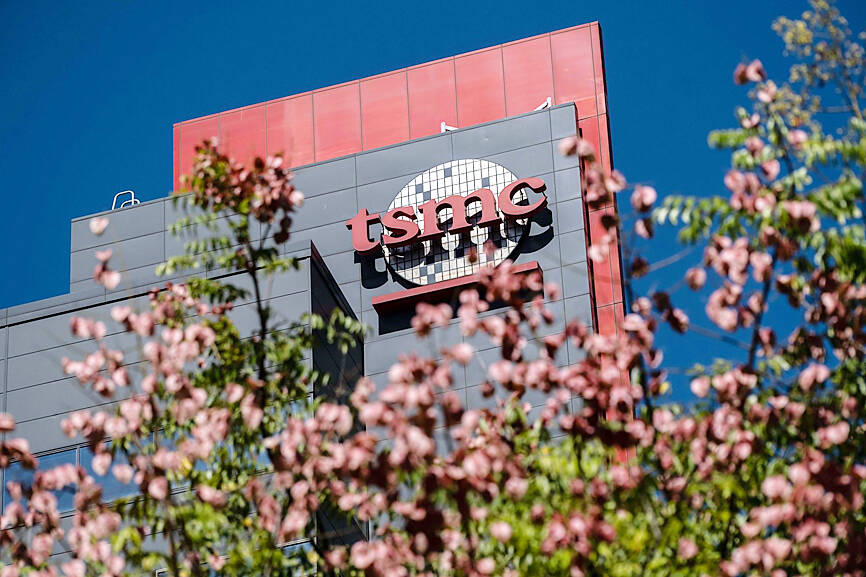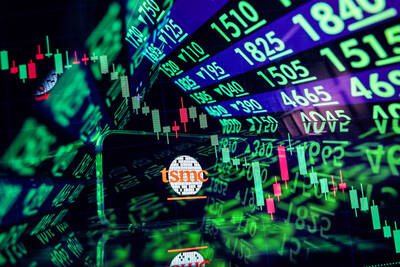Taiwan Semiconductor Manufacturing Co (TSMC, 台積電) has announced that plans to bring its advanced 2-nanometer (nm) technology into mass production by 2025 are still on track.
TSMC is battling to maintain its lead over main rivals Intel Corp and Samsung Electronics Co, which aim to start production of 2nm chips next year and in 2025 respectively.
TSMC announced the timeline for 2nm production at its North America Technology Symposium in Santa Clara, California, on Wednesday.

Photo: Bloomberg
More than 1,600 customers and partners registered to attend the event, the first of an international series of technology symposiums hosted by the world’s largest contract chipmaker, TSMC said.
During the event, TSMC showcased its latest technology developments, including progress in 2nm technology and new members of its industry-leading 3nm technology family, as well as 3DFabric, a comprehensive family of 3D silicon stacking and advanced packaging technologies.
The company said that the development of its 2nm technology, which utilizes nanosheet transistors, was making progress in yield and device performance, and it is set to enter production in 2025 as scheduled.
The company’s 2nm technology would be up to 15 percent faster than its 3nm enhanced (N3E) process technology at the same power, with up to 30 percent lower power use at the same speed, and chip density of more than 15 percent greater than N3E.
Regarding its N3E products, TSMC said its 3nm technology was in volume production, with an enhanced N3E version set to enter high-volume manufacturing in the second half of this year.
Following N3E, TSMC would continue to optimize the N3 family’s transistor density with 3nm performance enhanced technology, which would build on N3E by offering better power, performance and density, the company said, adding that production would be ready in the second half of next year.
Its N3X product, which is tailored for high-performance computing applications and can support higher voltage and frequency — and therefore has stronger computing power — is to enter mass production in 2025, it said.
In addition, its Auto Early product would be available this year, offering automotive process design kits based on N3E, and allowing customers to launch designs on the 3nm node for automotive applications, leading to the fully automotive-qualified N3A process in 2025, TSMC said.

Taiwan Semiconductor Manufacturing Co (TSMC, 台積電) last week recorded an increase in the number of shareholders to the highest in almost eight months, despite its share price falling 3.38 percent from the previous week, Taiwan Stock Exchange data released on Saturday showed. As of Friday, TSMC had 1.88 million shareholders, the most since the week of April 25 and an increase of 31,870 from the previous week, the data showed. The number of shareholders jumped despite a drop of NT$50 (US$1.59), or 3.38 percent, in TSMC’s share price from a week earlier to NT$1,430, as investors took profits from their earlier gains

In a high-security Shenzhen laboratory, Chinese scientists have built what Washington has spent years trying to prevent: a prototype of a machine capable of producing the cutting-edge semiconductor chips that power artificial intelligence (AI), smartphones and weapons central to Western military dominance, Reuters has learned. Completed early this year and undergoing testing, the prototype fills nearly an entire factory floor. It was built by a team of former engineers from Dutch semiconductor giant ASML who reverse-engineered the company’s extreme ultraviolet lithography (EUV) machines, according to two people with knowledge of the project. EUV machines sit at the heart of a technological Cold

TAIWAN VALUE CHAIN: Foxtron is to fully own Luxgen following the transaction and it plans to launch a new electric model, the Foxtron Bria, in Taiwan next year Yulon Motor Co (裕隆汽車) yesterday said that its board of directors approved the disposal of its electric vehicle (EV) unit, Luxgen Motor Co (納智捷汽車), to Foxtron Vehicle Technologies Co (鴻華先進) for NT$787.6 million (US$24.98 million). Foxtron, a half-half joint venture between Yulon affiliate Hua-Chuang Automobile Information Technical Center Co (華創車電) and Hon Hai Precision Industry Co (鴻海精密), expects to wrap up the deal in the first quarter of next year. Foxtron would fully own Luxgen following the transaction, including five car distributing companies, outlets and all employees. The deal is subject to the approval of the Fair Trade Commission, Foxtron said. “Foxtron will be

INFLATION CONSIDERATION: The BOJ governor said that it would ‘keep making appropriate decisions’ and would adjust depending on the economy and prices The Bank of Japan (BOJ) yesterday raised its benchmark interest rate to the highest in 30 years and said more increases are in the pipeline if conditions allow, in a sign of growing conviction that it can attain the stable inflation target it has pursued for more than a decade. Bank of Japan Governor Kazuo Ueda’s policy board increased the rate by 0.2 percentage points to 0.75 percent, in a unanimous decision, the bank said in a statement. The central bank cited the rising likelihood of its economic outlook being realized. The rate change was expected by all 50 economists surveyed by Bloomberg. The